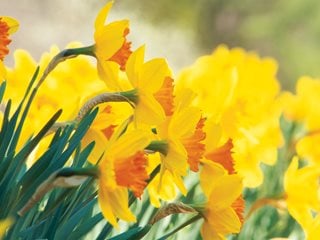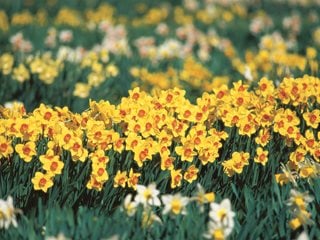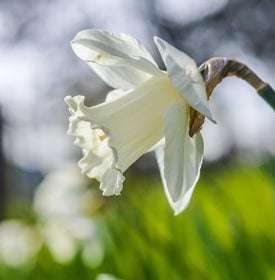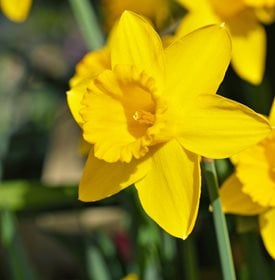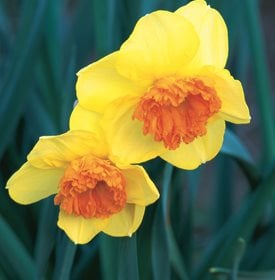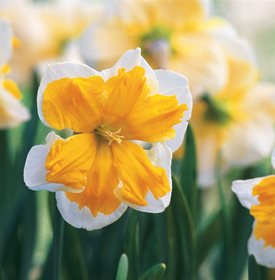Daffodils - A Guide to Growing Narcissus Flowers
Daffodils, along with tulips, are one of the most popular spring bulbs. They are long-lived; bloom for weeks on end; aren’t bothered by deer; thrive both in the garden and in pots; are easy to plant, grow and care for; and offer astounding variety (there are over 25,000 registered cultivars!).
On this page: Basics | Growing | Design Ideas | Pictures | FAQs | Using in Arrangements
- BASICS
- PLANTING DAFFODILS
- DAFFODIL CARE
- DESIGN IDEAS
- DAFFODIL PICTURES
- FREQUENTLY ASKED QUESTIONS
- USING DAFFODILS IN ARRANGEMENTS
DAFFODIL BASICS
Botanical Name:
Narcissus
Zones:
Varies by type. The majority are easy to grow in colder regions (Zones 4 to 8), most can withstand Zones 2 and 3, and many can survive warmer climates through Zone 9 (notably those in Jonquilla and Tazetta divisions).
Bloom time:
Daffodil flowers bloom in spring; some early, mid, and late, depending on the variety.
Exposure:
Best in full sun. Daffodils also need plenty of light even after flowering to store up energy for next year's bloom.
Height:
6 to 30 inches
Color and characteristics:
The most common colors are white and yellow, but there are also orange, pink, and red varieties. They are recognized mainly for their bell-shaped, central cup surrounded by a ring of petals.
Types of daffodils:
There are thousands to choose from, including:
- Modern hybrids, bred to be tall and sturdy with many flower shapes and colors
- Antique or heirloom types that have been grown for generations
- Smaller species daffodils (sometimes referred to as wild or miniature daffodils)
Those who grow them for competition are even more precise and classify them into 13 divisions (see The American Daffodil Society). The ones most commonly grown in gardens are known as Large Cup and Trumpet daffodils.
PLANTING DAFFODILS
When to plant daffodil bulbs:
- Colder regions: Plant in autumn after the first frost, but before the ground freezes.
- Warmer regions: Plant after fall temperatures have become consistent and nights are cool.
Where to plant daffodil bulbs:
Plant bulbs in an area that receives full sun both before and after blooming. Avoid areas that will be too shady when deciduous trees leaf out in spring and areas where they will get too wet—bulbs will rot if they sit in water.How deep to plant daffodil bulbs:
6 inches deep
Soil:
Daffodils prefer well-drained soil, where the bulbs can be relatively dry when dormant during summer. In heavier soil, it’s best to grow them in raised beds.
For more on how to plant bulbs, see Bulbs 101: Planting and Storing Bulbs.
DAFFODIL CARE
Water:
Some moisture is needed in fall after planting. In spring when plants are actively growing and until their leaves begin to turn yellow, water them 1/2 to 1 inch per week.
Fertilizer:
Add bone meal when planting.
Dividing:
If bloom quality and quantity degrade, dig up and divide clumps right after the foliage dies back.
Cutting back:
Wait to cut the leaves back until they turn yellow; they are gathering energy from sunlight to be stored in the bulb for next year's flowers.
DESIGN IDEAS
If you love daffodils, but aren’t sure how to use them in your garden, here are some suggestions:
- Plant in groups of 10 to 100 bulbs for bolder impact. If your planting is to be viewed from a distance, use bright yellows and oranges or plant light colors in front of darker, contrasting ones.
- Plant them on a bank or a hillside for a really showy display. Planting on a slope will also provide the necessary good drainage for the bulbs.
- Include early, midseason, and late bloomers to extend the season of bloom.
- Brent Heath, of Brent and Becky’s Bulbs, suggests layering daffodil bulbs among tulips, hyacinths, and muscari to create “living flower arrangements”.
- Slip bulbs amid daylilies, heuchera, and hosta in smaller garden beds and those plants will grow up to cover the fading leaves.
- Let them naturalize in open areas, meadows, and along fences for flowers for years to come.
- Daffodils are well-suited to designs that mimic woodland settings.
Companion plants:
Daffodils can provide a defensive shield against hungry deer. Self-sowing annuals that bloom after daffodils can hide the yellowing foliage.
Try planting alongside these plants:
- Magnolia trees
- Tulips
- Johnny jump-ups
- Forget-me-nots
- Daylilies
- Crabapple trees
- Creeping speedwell (Veronica peduncularis ‘Georgia Blue’)
- Primula veris
- Violas
- Vinca minor
- Lilies
DAFFODIL PICTURES
FREQUENTLY ASKED QUESTIONS
Are daffodils poisonous?
Daffodils contain a toxic chemical that may cause digestive trouble. They taste so awful that most animals avoid them. However, if your pet does eat a daffodil bulb you should contact your veterinarian. See more Common Poisonous Plants for Dogs and Cats.
Should I dig and store my bulbs after they go dormant or leave them in the ground?
Daffodils are a very hardy bulb that can be left in the ground for years in most cases. There are only a few circumstances that warrant otherwise. Dig them up and store them if:
- You live in a very warm climate and need to chill the bulbs in the refrigerator
- You live in an exceptionally cold climate and are worried they won’t overwinter in the ground
- You would like to plant the bulbs in a different spot next year
- Your bulbs have become crowded and need to be divided
- If the planting area will be wet during warm summer months, then remove and store the bulbs to avoid rot
Can I plant daffodil bulbs in the spring?
The ideal planting time for spring-flowering bulbs is during fall. Then they have all winter to acclimate and develop roots before blooming in spring. However, some gardeners have success transplanting potted bulbs into their spring gardens. Look for plants with healthy green foliage and buds, but not blooms.
When is the right time to transplant daffodils?
Whether you’re transplanting to alleviate crowding or you simply want to move them to a new spot, the best time to do so is after they go dormant. Once the flowers fade, wait for the leaves to wilt, yellow, and die off before digging up the bulbs—this should take approximately six weeks. During this time, the bulb is storing energy and preparing for next spring’s bloom. Replant the bulbs immediately in their new location.
Is there a trick to naturalizing daffodils?
Here are some expert tips for creating a naturalized planting:
- Pick an area with good drainage and sunlight
- Select daffodils that multiply quickly
- Plant drifts of the same kinds and colors
- Toss handfuls of bulbs about and plant them where they land
- Choose varieties that flower at different times
- Use a specialized bulb planting tool or drill attachment to make the process faster
The two terms “naturalize” and “perennialize” are sometimes used interchangeably, but there is a subtle difference. Some bulbs will naturalize, meaning they will prosper and spread about the garden, forming natural-looking groupings. Others are considered good perennializers in that they will return reliably year after year, increasing their clump size over time, but not necessarily moving farther out into the landscape.
USING DAFFODILS IN ARRANGEMENTS
Daffodils make great cut flowers. If you’d like to bring them indoors, here are some tips:
- Choose flowers that are just opening up, they will last longer in a vase
- Let them sit alone in water for 24 hours before combining them with other flowers
- Pair with tulips, Leucojum, lily-of-the-valley, or bare branches
- Combine daffodils from different divisions—try a trio of Tazetta, trumpet, and double narcissus
- Use milk glass, terra cotta pots, or repurposed kitchenware as a container
Related:
Bulbs 101: How to Plant and Store Bulbs
More Bulbs for Your Garden
Top 20 Spring-Blooming Bulbs
Growing Paperwhites
Bulbs for Warm-Climate Gardens
Updated: 2/24/21
